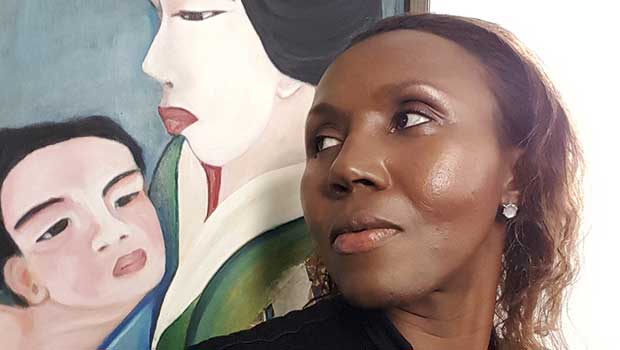Haitian painter/designer Colette Brésilla discusses her work as a feminine artist

“It’s just the most wonderful thing when you have confidence in yourself. It doesn’t matter what people say. You just do what you need to do, and that’s the way that I am right now,” says painter, textile designer and sculptor Colette Brésilla about her growth and transformation as an artist.
Speaking in her East Boston studio on a warm and sunny Sunday afternoon in August, the Haitian-born artist recalled stepping into the world of design as a young girl, stealing scraps of material from her seamstress mother’s work to create appliqués. She came to channel that creativity while attending Catholic primary school, especially on her favorite day, Thursdays, which was designated for embroidery and the arts.

Author: Courtesy Colette Brésilla“La Madonna Cachée” by Colette Brésilla.

Author: Courtesy Colette Brésilla“Inside God’s Heart” by Colette Brésilla.
On the Web
For more information about Colette Brésilla and to view her art, visit: www.colettebresil…
Brésilla grew up in a religious family both in Haiti and in the United States, with a minister father and a church-going mother. Brésilla was expected to pursue a career in medicine, law or engineering. She completed two years of pre-med, but realized she had to follow her true calling as an artist.
Despite being considered “a rebel” by her family, Brésilla attended the School of the Museum of Fine Arts in Boston, where in 1992 she earned her bachelor’s degree in fine arts, concentrating on Chinese and Japanese paintings, African Textile Design and Italian Technical Painting. As a working artist for 25 years, Brésilla feels that she has grown tremendously, especially with respect to her painting. “After I graduated from art school, I felt afraid for the world to see my art, because of the critics. I was always painting while, in a way, almost hiding. My colors were dark—even though they were bright, they were dark,” she recalled. “I was trying to hide myself, thinking that maybe they won’t criticize it, if I paint like this.
But the woman who believes that art is in her blood couldn’t dim her light forever. In 1999, something within her changed. “Everything exploded,” she said. “I’m like, ‘I am all naked now.’ You can see me. I don’t care. I’m just going to paint what’s coming out of me. I’m not going to let fear control what I paint, what I create—so I just let it out. It was the most wonderful thing that I have ever done.”
Since then, she has created numerous thought-provoking, bold, provocative and colorful paintings. Her artwork has been showcased extensively in numerous American and international institutions, including galleries, museums and universities, and housed in a variety of permanent corporate and private collections.
Many of her works have concentrated on the female figure, specifically the Japanese geisha, as reflected in “Yeux de Jade/Jaded Eyes,” “The Thinker II,” “Chantale,” “Gesturing Geisha” and “Geisha Française.” Her fascination with the Japanese geisha began when she was a child. She often would clip portraits from magazines, especially those portraying Asian women. “I was always so curious about Chinese and Japanese women,” says Brésilla. In many of her paintings, the geisha are either smoking pipes or breastfeeding, almost always wearing lipstick in a bold color.
She recalls that, as a child, she often would see women walking in the Haitian mountains with a basket on their head and a pipe in their mouth. She didn’t consider this sight unusual, as she had great aunts who were pipe smokers. For Brésilla, the pipes represent the women’s voice. “It’s their mouthpiece,” she explained.
Brésilla believes that art “is a form of transformative healing,” and considers herself “a cultural worker for social change,” according to her website’s artist statement. She responds to the world around her by creating various forms of art, whether it’s in the form of mixed media sculptures such as “Ange/Angel” and “Les Jumelles/The Female Twins,” tapestries like “The Stitched Prayers’ Series,” abstract paintings such as the “Silent Warrior” or still life paintings like “Happy Bouquet.”
A self-described feminine artist whose work is always “reflecting women empowerment,” there is no retirement for Brésilla. With the current social and political climate in disarray, Brésilla knows that there’s much work to be done, especially with a man in the White House, whom she doesn’t address by name, who “disrespects women” and thinks “women are just like trash.”
Brésilla sums up by saying, “I’ve been fighting that for a long time and I will not stop fighting it until I die.”






